Acetylated tau destabilizes the cytoskeleton in the axon initial segment and is mislocalized to the somatodendritic compartment
- PMID: 27356871
- PMCID: PMC4928318
- DOI: 10.1186/s13024-016-0109-0
Acetylated tau destabilizes the cytoskeleton in the axon initial segment and is mislocalized to the somatodendritic compartment
Abstract
Background: Neurons are highly polarized cells in which asymmetric axonal-dendritic distribution of proteins is crucial for neuronal function. Loss of polarized distribution of the axonal protein tau is an early sign of Alzheimer's disease (AD) and other neurodegenerative disorders. The cytoskeletal network in the axon initial segment (AIS) forms a barrier between the axon and the somatodentritic compartment, contributing to axonal retention of tau. Although perturbation of the AIS cytoskeleton has been implicated in neurological disorders, the molecular triggers and functional consequence of AIS perturbation are incompletely understood.
Results: Here we report that tau acetylation and consequent destabilization of the AIS cytoskeleton promote the somatodendritic mislocalization of tau. AIS cytoskeletal proteins, including ankyrin G and βIV-spectrin, were downregulated in AD brains and negatively correlated with an increase in tau acetylated at K274 and K281. AIS proteins were also diminished in transgenic mice expressing tauK274/281Q, a tau mutant that mimics K274 and K281 acetylation. In primary neuronal cultures, the tauK274/281Q mutant caused hyperdynamic microtubules (MTs) in the AIS, shown by live-imaging of MT mobility and fluorescence recovery after photobleaching. Using photoconvertible tau constructs, we found that axonal tauK274/281Q was missorted into the somatodendritic compartment. Stabilizing MTs with epothilone D to restore the cytoskeletal barrier in the AIS prevented tau mislocalization in primary neuronal cultures.
Conclusions: Together, these findings demonstrate that tau acetylation contributes to the pathogenesis of neurodegenerative disease by compromising the cytoskeletal sorting machinery in the AIS.
Keywords: Alzheimer’s disease; Axon initial segment; Neuronal cytoskeleton; Neuronal polarity; Tau acetylation.
Figures
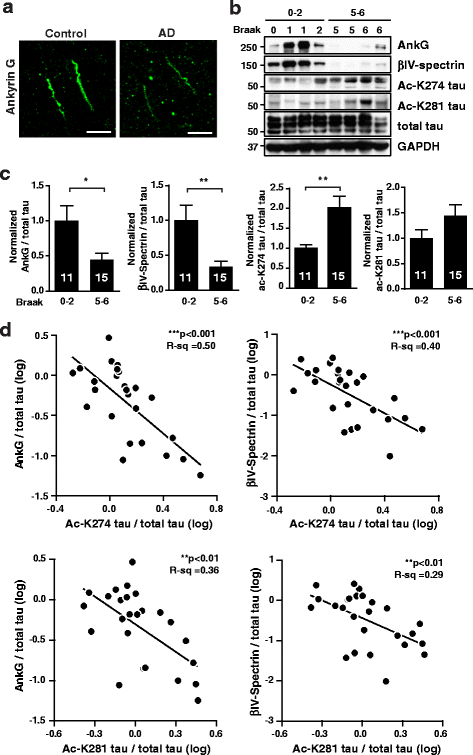
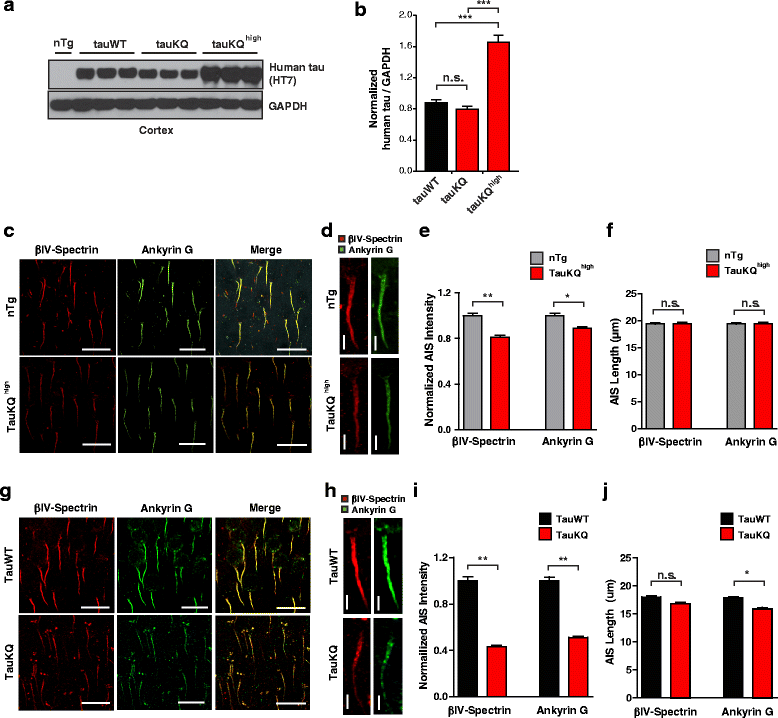
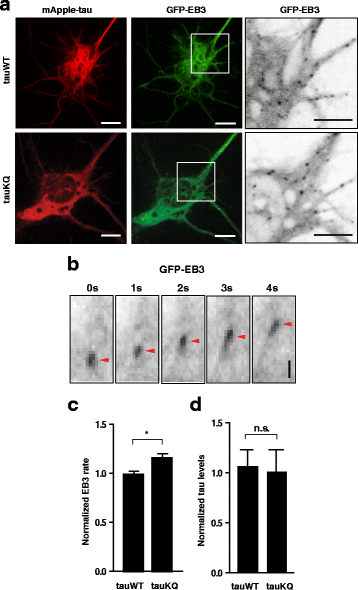
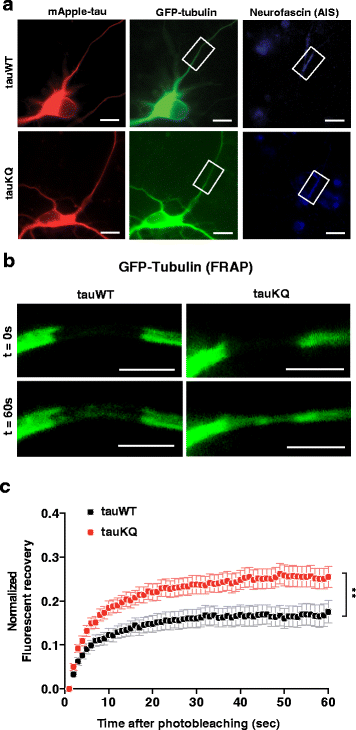
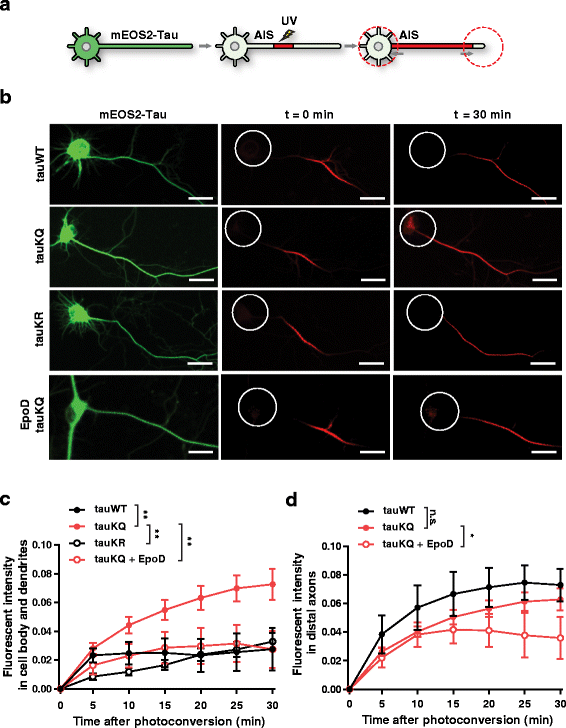
Similar articles
-
Axodendritic sorting and pathological missorting of Tau are isoform-specific and determined by axon initial segment architecture.J Biol Chem. 2017 Jul 21;292(29):12192-12207. doi: 10.1074/jbc.M117.784702. Epub 2017 May 23. J Biol Chem. 2017. PMID: 28536263 Free PMC article.
-
Extracellular Tau Oligomers Damage the Axon Initial Segment.J Alzheimers Dis. 2023;93(4):1425-1441. doi: 10.3233/JAD-221284. J Alzheimers Dis. 2023. PMID: 37182881 Free PMC article.
-
Aging Does Not Affect Axon Initial Segment Structure and Somatic Localization of Tau Protein in Hippocampal Neurons of Fischer 344 Rats.eNeuro. 2017 Jul 21;4(4):ENEURO.0043-17.2017. doi: 10.1523/ENEURO.0043-17.2017. eCollection 2017 Jul-Aug. eNeuro. 2017. PMID: 28785724 Free PMC article.
-
Axon Initial Segment Cytoskeleton: Architecture, Development, and Role in Neuron Polarity.Neural Plast. 2016;2016:6808293. doi: 10.1155/2016/6808293. Epub 2016 Jul 17. Neural Plast. 2016. PMID: 27493806 Free PMC article. Review.
-
Mechanisms of Axonal Sorting of Tau and Influence of the Axon Initial Segment on Tau Cell Polarity.Adv Exp Med Biol. 2019;1184:69-77. doi: 10.1007/978-981-32-9358-8_6. Adv Exp Med Biol. 2019. PMID: 32096029 Review.
Cited by
-
Transcriptomic alterations in APP/PS1 mice astrocytes lead to early postnatal axon initial segment structural changes.Cell Mol Life Sci. 2024 Nov 1;81(1):444. doi: 10.1007/s00018-024-05485-9. Cell Mol Life Sci. 2024. PMID: 39485512 Free PMC article.
-
A combinatorial native MS and LC-MS/MS approach reveals high intrinsic phosphorylation of human Tau but minimal levels of other key modifications.J Biol Chem. 2020 Dec 25;295(52):18213-18225. doi: 10.1074/jbc.RA120.015882. Epub 2020 Oct 26. J Biol Chem. 2020. PMID: 33106314 Free PMC article.
-
Axon outgrowth and neuronal differentiation defects after a-SMN and FL-SMN silencing in primary hippocampal cultures.PLoS One. 2018 Jun 14;13(6):e0199105. doi: 10.1371/journal.pone.0199105. eCollection 2018. PLoS One. 2018. PMID: 29902268 Free PMC article.
-
Actin polymerization and longitudinal actin fibers in axon initial segment plasticity.Front Mol Neurosci. 2024 May 10;17:1376997. doi: 10.3389/fnmol.2024.1376997. eCollection 2024. Front Mol Neurosci. 2024. PMID: 38799616 Free PMC article.
-
Resveratrol Mitigates Hippocampal Tau Acetylation and Cognitive Deficit by Activation SIRT1 in Aged Rats following Anesthesia and Surgery.Oxid Med Cell Longev. 2020 Dec 16;2020:4635163. doi: 10.1155/2020/4635163. eCollection 2020. Oxid Med Cell Longev. 2020. PMID: 33381265 Free PMC article.
References
Publication types
MeSH terms
Substances
Grants and funding
LinkOut - more resources
Full Text Sources
Other Literature Sources
Medical
Molecular Biology Databases

